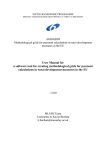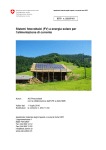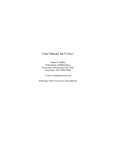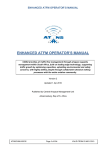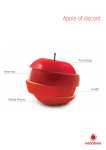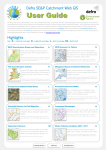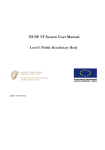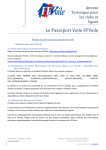Download User manual - The Macaulay Land Use Research Institute
Transcript
AGRIGRID Methodological grids for payment calculations in rural development measures in the EU (Project Reference: SSPE-CT-2006-044403) Specific Targeted Research Project under priority 8.1 Sustainable management of Europe’s natural resources: 8.1.B.1.1 Modernisation and sustainability of agriculture and forestry, including their multifunctional role in order to ensure the sustainable development and promotion of rural areas Task 14 New methods for calculating premiums in the rural development measures Report D12 User manual for AGRIGRID Software Tool Task managers: Kevin Buchan, Gerald Schwarz, Jane Morrice, Keith Matthews and Pernette Messager (MLURI) With contributions from: Johann Heinrich von Thuenen Institut (vTI), Agricultural University of Athens (AUA), Institute of Agricultural Economics and Information (UZEI), Lithuanian Institute of Agrarian Economics (LAEI), MTT Agrifood Research Finland (MTT), National Institute of Agricultural Economics (INEA), Humboldt University Berlin (HUB) and Instituto de Desarrollo Rural Sostenible (IDRiSi). Approved by Work Package Manager of WP8: Date: December 2008 Luca Cesaro, INEA Approved by Project Coordinator: Date: December 2008 Gerald Schwarz, MLURI This document was produced under the terms and conditions of Contract SSPE-CT-2006 044403 for the European Commission. Contents 1 Introduction ..................................................................................................................................................... 3 2 1.1 What is AGRIGRID? ............................................................................................................................... 3 Setup ................................................................................................................................................................. 5 2.1 System Requirements ............................................................................................................................... 5 2.1.1 Operating System ................................................................................................................................ 5 2.1.2 Microsoft .NET Framework ................................................................................................................ 5 2.1.3 Other Software Requirements ............................................................................................................. 5 2.1.4 Disk Space Requirements.................................................................................................................... 5 2.1.5 Recommended System ........................................................................................................................ 6 2.2 Installation ............................................................................................................................................... 6 2.2.1 Installation from CD ........................................................................................................................... 6 2.2.2 Installation from Downloaded Setup File............................................................................................ 6 2.2.3 Setup Process ...................................................................................................................................... 6 2.2.4 Prerequisites: .NET Framework and Windows Installer ..................................................................... 6 2.2.5 AGRIGRID Setup Wizard .................................................................................................................. 7 3 Operating Instructions .................................................................................................................................... 9 3.1 Getting Started ......................................................................................................................................... 9 3.1.1 Running the Software .......................................................................................................................... 9 3.1.2 Data Libraries ...................................................................................................................................... 9 3.1.3 Overview of the Grid Configuration Process .................................................................................... 10 3.1.4 Creating a Grid .................................................................................................................................. 11 3.1.5 Main Grid Window ........................................................................................................................... 12 3.1.6 Editing General Grid Settings ........................................................................................................... 13 3.2 Linkages ................................................................................................................................................. 14 3.2.1 Data-entry Approaches ...................................................................................................................... 14 3.2.2 Balance Sheet Approach ................................................................................................................... 14 3.2.3 Practices Approach............................................................................................................................ 15 3.2.4 Creating a Linkage ............................................................................................................................ 16 3.2.5 Specifying the RD Commitments...................................................................................................... 18 3.2.6 Specifying a Baseline ........................................................................................................................ 18 3.2.7 Editing Regulations ........................................................................................................................... 21 3.2.8 Specifying Revenues and Costs ........................................................................................................ 22 3.3 Differentiation (of costs and revenues) .................................................................................................. 25 3.3.1 Editing the Library of Differentiation Categories and Elements ....................................................... 28 3.4 Specifying Values for Costs & Revenues .............................................................................................. 28 3.4.1 Data Entry Using Sub-masks ............................................................................................................ 30 3.4.2 Representation of Revenues and Costs ............................................................................................. 32 3.5 Transaction Costs ................................................................................................................................... 32 3.6 Differentiation (of RDR Payment Limits) ............................................................................................. 33 3.7 RDR Payment Limits ............................................................................................................................. 34 3.8 Grid Outputs .......................................................................................................................................... 35 3.8.1 Viewing Grid Outputs ....................................................................................................................... 35 4 Uninstalling .................................................................................................................................................... 38 5 Troubleshooting ............................................................................................................................................. 39 2 1 Introduction 1.1 What is AGRIGRID? AGRIGRID aims to develop methodological grids for the calculation of payments in rural development measures in EU member states. The project covers a representative set of EU member states including Scotland, Germany, Finland, Lithuania, Czech Republic, Italy, Greece, Poland and Spain. These countries cover a range of natural and agronomic conditions from intensive farming with good soils and favourable climatic conditions, to extensive livestock systems in marginal areas with unfavourable natural conditions isolated from markets. The priorities in the Rural Development Plans differ in the partner countries covering all relevant RD measures. The project develops methodological grids for agri-environment measures, compensatory allowances, Natura 2000 payments, forestry measures and animal welfare and meeting standard measures. The project has three main objectives: - To carry out a comparative of the methods applied by the member states and their regions for calculating the various aids for their current rural development programmes, grouped by measure. To elaborate and recommend methodological grids that are based on objective and quantifiable criteria. They should be applicable EU-wide and differentiated by the nature of the measure. To elaborate, based on the methodological grids, an appropriate software tool for applying this grid in the individual measures and cases and recommendations for the assessment of payment calculations. Developing methodological grids for the payment calculation in different RD measures requires a detailed knowledge of present conditions and methods at both production level and policy level. At the production level, it is necessary to gather data on the structure and characteristics of the farming sector including natural and agronomic conditions and production systems and techniques. At the policy level, it is necessary to know the existing methods for payment calculations in RD measures and their impacts on that structure. Existing payment calculations have been reviewed in nine European countries to obtain a better understanding of how the calculations are carried out and to collate a comprehensive database of calculation components. The review provides the basis for identifying new methods for payment calculations and the development of grids. Based on the review of payment calculations, logic frameworks for the payment calculations in rural development measures have been developed. These logic frameworks provide a generic structure and a clearer exposition of the calculation process. Following the logic frameworks, the different core parts of the calculation process have been identified including baseline requirements, relevant commitments defined in the rural development measures, lists of practices reflecting required changes in farm management, lists of cost, revenue and income components and payment differentiation categories and elements. These parts have then been integrated in the logic models creating methodological grids for payment calculations. One of the main challenges in the AGRIGRID project was to develop a harmonised method for calculating payments across the EU. The methodological grids provide such a harmonised method through an easy-to-follow generic template of seven main calculation steps (Figure 1). The generic template of the step-by-step approach has then been expanded for the different rural development measures according to measure-specific characteristics1. In addition to providing a harmonised method for payment calculations, the structure and flexibility of the methodological grids also ensure that this new method can be applied with different levels of details and available data. The software tool provides a user friendly platform for the application of the methodological grids developed in Excel and enables end users to calculate payments applying a harmonised step-by-step approach while maintaining sufficient scope to account for variations in available data. In addition, a comparative analysis of different approaches for payment differentiations in selected countries provides valuable information for the elaboration of best-practice examples for suitable payment differentiations which are added to the tutorials of this user guide. This document provides a detailed user guide for the AGRIGRID software tool with instructions for applying the developed methodological grids through the software tool, including tutorials showing a set of calculation examples across the different rural development measures. 1 More information on the grid development is published in the grid development reports available on the project website http://www.macaulay.ac.uk/agrigrid/ 3 Step 1: Select approach for payment calculation (Balance sheet (FADN) or practices approach) Step 2: Create and fill linkage table Step 3: Definition of payment differentiation Step 4: Calculation and/or source of practices and cost/revenue components Step 5: Quantification of transaction costs (where applicable) Step 6: RDR payment limits: Overview and calculation of eligible payment elements Step 7: Overview of calculated payments Figure 1: Step-by-step approach for calculating payments with the grids 4 2 Setup 2.1 System Requirements 2.1.1 Operating System The AGRIGRID software tool is designed for use with Microsoft Windows® XP although it should be compatible with most other versions of Windows. Ensure that you have the latest Windows updates (i.e. service pack and critical updates) installed – these can be downloaded from the Windows Update website. 2.1.2 Microsoft .NET Framework The AGRIGRID software tool utilises .NET Framework 2.0. Therefore it is necessary to install the Microsoft .NET Framework 2.0 Redistributable Package (free download from Microsoft). If you are connected to the internet the setup process should automatically download the files that you need. You should also ensure that you have the latest service pack and updates for the .NET Framework by visiting the Windows Update website. You may also need the language pack specific to your locale. To check whether you have the .NET Framework 2.0 installed on your system consult your Add or Remove Programs via the Control Panel (Figure 2). Figure 2: Checking the version of the .NET Framework 2.1.3 Other Software Requirements The electronic documentation is available in PDF format and requires Adobe Reader software (free download from Adobe). 2.1.4 Disk Space Requirements The following are the approximate disk space requirements: 5 Microsoft .NET Framework AGRIGRID software tool Adobe Reader 200 MB 50 MB 100 MB 2.1.5 Recommended System The following is the recommended system specification: Microsoft Windows XP Service Pack 2 or later, including Windows Installer 3.1 or later and Internet Explorer 6.0 or later .NET Framework 2.0 Service Pack 1 Adobe Reader 500MB free disk space Screen resolution of 800 x 600 or higher Internet connection 2.2 Installation 2.2.1 Installation from CD Insert the disc labelled AGRIGRID Software Tool into your CD-ROM drive. After a few seconds the auto-run feature should launch the setup program. If the program does not appear, you may have auto-run disabled. To manually start the setup process, open My Computer and browse the CD-Rom drive containing the installation CD. Double-click on the setup-.exe file to launch the setup program. 2.2.2 Installation from Downloaded Setup File Unzip the downloaded setup archive and run the enclosed setup.exe program. 2.2.3 Setup Process The software bundle is provided in English but should operate correctly in non-English locales. 2.2.4 Prerequisites: .NET Framework and Windows Installer If you do not have the correct version of the .NET Framework or Windows Installer installed, then you will be prompted with the window shown in Figure 3. 6 Figure 3: Installing required components Once you accept the terms of the end user licence agreement, the required files will be automatically downloaded (Figure 4). Figure 4: Downloading required components If you do not have an internet connection you will need to download and install the Microsoft .NET Framework Version 2.0 Redistributable Package by some other means. 2.2.5 AGRIGRID Setup Wizard Once all of the prerequisite components have been installed (this can take several minutes to complete depending on internet connection speed), you will be prompted with the AGRIGRID setup wizard (Figure 5). Figure 5: Running the setup wizard 7 Follow the on-screen prompts to complete the installation. When prompted for the installation directory the wizard will suggesting the following default 2: C:\Program Files\AGRIGRID\ You have the choice of keeping this default or changing it to some other location. The installation directory will contain the following sub-directories: \Documentation\ PDF documentation describing the software and giving examples \System\ Software system files such as executables \Libraries\ Input data files such as baselines and differentiation \Grids\ Output files from the software are called grid files and are stored in this directory You are not tied in to using these folders to store your data files but these will be the default folders that the software will start in when opening or saving data files for the first time. The setup process will provide you with start menu options for viewing documentation and running the software. For convenience, a shortcut to the software will also be placed on the desktop. 2 This path may vary from PC to PC – the installation program should detect the correct location for programs 8 3 Operating Instructions 3.1 Getting Started 3.1.1 Running the Software To start the AGRIGRID software, click the shortcut on your desktop or within the AGRIGRID program group accessed via the start menu. When the software starts up, the welcome screen (Figure 6) will be displayed while the software loads and configures various settings. Figure 6: Welcome screen After a few seconds the main AGRIGRID window will be displayed (Figure 7). Figure 7: Starting-up This window is fairly simple - it allows you to create or open a grid (page 11), display the About window and edit manage the data libraries. 3.1.2 Data Libraries Before you can begin creating grids you need to create a data library – a repository for the data you will share between grids (saving you time and effort by avoiding the need to repeatedly enter the same data). Part of the process of developing a grid involves the repetitive usage of input data such as baseline, differentiation and cost components. In order to facilitate the re-use of these inputs and to reduce the data entry load for the user the software provides a library for storing this information and allows you to easily call upon the information when it is needed. You can edit library files and share them with other users. The software allows you to keep multiple libraries and provides the potential for downloading new libraries if they became available. For instance, it might be desirable to keep separate libraries for each country and you could switch between these libraries to suit the grid in question. 9 When input data from a library is used by AGRIGRID, it creates a copy of the data so that the grid file can operate independently of the libraries used to create it. You can edit the data libraries at any time by clicking the Library button on the start-up window. This action displays the window shown in Figure 8. Figure 8: Data libraries The window contains shortcuts to all of the editable input data libraries used by AGRIGRID. Clicking the Config button displays the library management window shown in Figure 9. This window allows you to perform operations such as creating a new library, switching to another library or saving the library with a new name. Figure 9: Library management 3.1.3 Overview of the Grid Configuration Process There are several steps to creating a grid and calculating a payment. The software tool builds on the step-by-step approach used to develop the methodological grids (Figure 1). Figure 10 expands upon this step-by-step procedure by showing the interaction of the key windows within the software. 10 Specify general settings NEW OPEN 1 Select approach for payment calculation for each calculation/payment... Main window 2 7 Create and fill linkage table 3 Define payment differentiation 4 Prepare practice/cost & revenue/income components 5 Quantify transaction costs 6 Specify RDR payment limits (including differentiation) View final calculated payment(s) Figure 10: Grid configuration process The user begins by specifying the measure and the data entry approach (i.e. balance sheet or practices) (step 1). Next, they are presented with the main grid window from which they can: Specify the general grid settings (pages 12 & 13) Configure the payment calculation(s) for the grid View the summary and detailed outputs (page 32) The configuration of a payment calculation is broken down into six further steps: 2. 3. 4. 5. 6. 7. Creation of linkages (i.e. relationship) between baseline, RD commitment, costs & revenues (page 14) Specification of how the payment is to be differentiated (page 25) Population of the cost, revenue and income figures as specified in the previous steps (page 28) Specification of transaction costs (page 32) Specification of how the RDR limits are to be differentiated (page 33) Specification of RDR limits (page 34) 3.1.4 Creating a Grid When creating a grid, the new grid window (Figure 11) is displayed. Here, the user chooses the measure and the data-entry approach. This is the only chance to set these – they cannot be changed later. Figure 11: Creating a new grid The software is pre-configured with the following set of RD measures: 131 - Meeting Standards 211 - Natural handicap payments in mountain areas 212 - Natural handicap payments in other than mountain areas 213 - Natura 2000 payments on agricultural land 214 - Agri-environment payments 215 - Animal welfare payments 221 - First afforestation of agriculture land 222 - First afforestation of agroforestry systems 223 - First afforestation of non-agricultural land 224 - Natura 2000 payments on forestry land 11 225 - Forest-environment payments The software allows the user to define grids for these RD measures with an option to define the grid at the submeasure level if this is more appropriate (page 12). The software does not provide a list of predefined submeasures due to the variability between countries. You must also consider which approach to take for the entry of cost and revenue components - there are two options. The first is to provide costs and revenues using a balance sheet approach (i.e. following the FADN format). The second is to provide the information in the form of a practices approach. The approaches cannot be mixed or changed so the most appropriate approach must be selected upon this window before proceeding. See Data-entry Approaches on page 14 for more details. 3.1.5 Main Grid Window The main grid window (Figure 12) is displayed when you create a new grid or open an existing grid. Here you should provide (where applicable) a short description of the sub-measure, the country and region (e.g. NUTS3 1 or 2). Figure 12: Main Grid window On this window you can also: Edit further general grid settings Edit the calculation View the outputs Save the grid When preparing a grid, the software will usually record all costs and revenues within a single payment calculation. For some measures there are separate payments made, so the software requires the user to prepare more than one calculation. For example, in the afforestation measures payments are made for: Establishment Costs Maintenance Costs Income Foregone The software has been pre-configured with this information so that, when these measures are selected, the software will prompt the user to define all of the necessary calculations. Tip: If you wish to prepare a grid that is similar to another then, to save time, open the original grid file, make the modifications and use the „Save As‟ button to save the grid under a new filename. 3 Nomenclature of Territorial Units for Statistics 12 3.1.6 Editing General Grid Settings The general grid settings window is shown in Figure 13. It allows you to customise some additional generic attributes for the grid. Figure 13: General Grid Settings Some member states are not currently part of the single European currency and as such the calculation of the grids will be done in the local currency (e.g. GBP or CZK). In order to deal with this, the AGRIGRID software requires member states to specify the following information: Calculation Currency Exchange rate to Euro In addition to the Euro the software has been pre-configured with the following currencies: Bulgaria - lev (BGN) Czech Republic - koruna (CZK) Denmark – krone (DKK) Estonia - kroon (EEK) Great Britain – pound sterling (GBP) Hungary - forint (HUF) Latvia - lats (LVL) Lithuania - litas (LTL) Poland - złoty (PLN) Romania - leu (RON) Slovakia - koruna (SKK) Sweden - krona (SEK) The calculation (up to and including the inclusion of transaction costs) is performed in the Calculation Currency. If Calculation Currency is not EUR then the software will use the exchange rate to convert back to Euro before applying the RDR limits which are always specified in Euro. The final payment information is always displayed in Euro. The Main Calculation Unit attribute allows you to specify the main unit for the calculation. The software provides the following options: Ha Livestock Unit Holding 13 3.2 Linkages 3.2.1 Data-entry Approaches There are two data-entry options for providing costs and revenues: Balance sheet approach Practices approach The two approaches cannot be mixed (or changed later in the process) so you must decide which approach to use and select it upon the new grid window (page 11). 3.2.2 Balance Sheet Approach The Farm Accountancy Data Network (FADN)4 consists of a harmonised annual survey of agricultural holdings carried out by the Member States of the European Union. The balance sheet approach provided by the AGRIGRID software uses the coding system used within the FADN database to organise the costs and revenues (e.g. the code SE350 refers to “contract work”) but does not necessarily expect the user to use the data contained in the FADN database. The hierarchical FADN structure is fixed (i.e. not editable). The example in Figure 14 shows the revenue items contained within the hierarchy. Figure 14: Balance Sheet Approach: Revenue list 4 Farm Accountancy Data Network - the European farming classification system (http://ec.europa.eu/agriculture/rica/index_en.cfm) 14 The hierarchical representation is intended to help the user understand how the different cost and revenue items are related. Items in the hierarchy are the made up from their sub-elements so, for example, SE135 Total output crops and crop production is equal to the sum of SE140, SE145, SE146 etc. A benefit of having this nested structure is that there is the option of providing values at higher or lower levels of detail depending on the availability of data. If you specify values at a lower level, then the software will automatically calculate the higher level values. Tip: use the tick boxes for selecting. For editing items in the lists, ensure you highlight the entry. 3.2.3 Practices Approach The balance sheet approach, discussed above, considers costs and revenues at a whole farm level. This might not be appropriate in all circumstances so the software provides an alternative practices approach so that the user can group costs within practices (e.g. mowing, fertilisation etc). Figure 15 shows the practices list with the practices Care of under tree area and Forest beating up selected. Each of these is made up of several costs (shown in red) such as Seedlings for forestry, Contract work and Rents. Figure 15: Practices approach: Practice list An additional benefit of having this nested structure for practices is that there is the option of providing values at the practice level or at the cost level depending on the availability of data. If you specify values for the costs, then the software will automatically calculate the values for the practice. The software maintains two lists for the practices approach: 15 revenues/incomes practices (including nested costs) The components within these lists are editable and practices are classified in order to make it easier to retrieve the data. 3.2.4 Creating a Linkage The AGRIGRID software defines a linkage as the combination of an RD commitment, a baseline, a set of revenues and a set of costs (optionally nested within practices - practices approach only). The window shown in Figure 16 is used to configure the linkages for a payment calculation. Figure 16: Linkage window with second linkage selected The linkages are summarised in the window. The idea is that arranging the data in this logical manner will help you to identify the costs and revenues that should be included in the grid. If you click the New button, the software will create a new linkage. If you select one of the linkages and click Edit, the software will allow you to edit the selected linkage. The Delete button lets you delete the selected linkage. Tip: You can adjust the column widths by dragging the dividers between each column header. An entry from the linkage table is shown in Figure 17. 16 Figure 17: Creating a new Linkage There are two mandatory steps to configuring a linkage: Specify the RD Commitment Specify the baseline Then, depending on the approach being followed, you must enter revenue and cost information as described in the following sections: Specify revenue, income and cost components – balance sheet approach Specify revenue and income components and practices – practices approach As noted earlier (Data-entry Approaches on page 14), the practices approach requires you to define costs within practices. 17 3.2.5 Specifying the RD Commitments You can specify the RD commitment by clicking the set button next to the RD commitment attribute in Figure 17. This displays the RD Commitment window shown in Figure 18. If the desired entry is not in the list, then the user can use the New button to create a new entry in the library. Figure 18: Editing and selecting Rural Development Commitments The RD Commitments are tied into each RD Measure so the software will maintain separate lists for each measure – and therefore only display those commitments that apply to the measure in question. 3.2.6 Specifying a Baseline To configure a baseline within the software, click the set button situated next to the baseline attribute (Figure 17). This launches the window shown in Figure 19. 18 Figure 19: Window for setting a baseline The purpose of this window is to help us identify the baseline (or reference level). The software represents two types of baseline: common practice and a baseline based upon one or more regulations. For the regulatory baselines, there are three types: Statutory Management Requirements (SMR) Good Agricultural and Environmental Conditions (GAEC) Additional (Regional) Baseline You can specify a title and select the type of baseline (i.e. common practice or regulatory). If it is a regulatory baseline, then you should also select the regulations that apply by clicking New – this displays the list of regulations (Figure 20). If necessary you can supersede regulatory baselines with more restrictive common practices – this is easily achieved by selecting the regulations that apply, setting the type attribute to „Common‟ and using the notes attribute to explain how the regulations are being exceeded. In a similar fashion, the notes attribute could also be used to indicate when only part of a regulation applies. 19 Figure 20: Baseline regulations If the relevant regulations are not in the library, you can create or edit an entry (see Editing Regulations on page 21), or use the Library button to open a different library in order to locate the regulation. When the user clicks the ok button, software will record the changes and return to the linkage window. Tip: use the tick boxes for selecting. For editing items in the lists ensure you highlight the entry. 20 3.2.7 Editing Regulations The regulations window is shown in Figure 21. Figure 21: Regulation window It is fairly simple and allows you to provide a type categorisation for the regulation, a short title and a larger section that can be used to describe the regulation in more detail. A sample set of SMR, GAEC and additional regulations will be provided in the supplied regulation library; however you can supplement the library with the regulations that apply in your country/region. 21 3.2.8 Specifying Revenues and Costs The user specifies a new cost or revenue by clicking the new button next to the cost or revenue box shown in Figure 17. Figure 22 shows the windows for selecting a revenue component using the balance sheet approach. Figure 22: Selecting Revenues for Balance Sheet Approach To help with navigation you can use the + and – buttons to explode and contract the hierarchy. With the balance sheet approach the software will allow you to specify the same costs and revenues within different linkages; however they will only be included once in the final calculation. For the practices approach the procedure for adding practices is similar. Figure 17 shows an example of adding a practice. Tip: use the tick boxes for selecting. For editing items in the lists ensure you highlight the entry. 22 Figure 23: Selecting Practices/Costs for Practices Approach When following the practices approach, the practices are nested within their classifications to help you to find the component you are searching for. Select the practice that you require and click Ok to include it in the linkage. If the desired entry is not provided in the list, then you can use the new, edit and delete controls to modify the contents of the pick-list – for example Figure 24 shows the editor for a practice (practices approach). 23 Figure 24: Editing a practice (practices approach only) When following the practices approach, you can select revenues or incomes depending on which is most appropriate (Figure 25). 24 Figure 25: Practices approach - revenues and incomes 3.3 Differentiation (of costs and revenues) Differentiation is the criterion under which an RD payment is distinguished. By specifying differentiation categories within the software, you can create a series of alternative scenarios for a payment calculation. A differentiation category such as type of trees is defined to contain a series of differentiation elements such as conifer or native woodland. The software provides a mechanism for differentiating payment based on the specification of one or more of these categories and elements. Note: Differentiation elements must not be confused with the different cost/revenue components used in the calculation of an individual payment. For example, if a RDP states that a payment is different for cereals and industrial crops, then these two types of crop are differentiation elements; however if cereals and industrial crops are characterised by the same payment but the calculation refers to both crops (e.g. calculating the average value of cost/revenue), then the two types of crop cannot be considered as differentiation elements. Also, eligibility criteria (e.g. minimum area under contract, or payments granted only for NVZs) cannot be considered as differentiation elements. If the payment calculation is to be differentiated, then the first step that you need to take is to click the Edit button labelled Differentiation of Payment Calculation upon the Payment Calculation window (see Creating a Linkage on page 16). This displays the differentiation window shown in Figure 26. 25 Figure 26: Differentiation The top of the window shows the list of differentiation categories that are included in this grid. When a selection is made here, the bottom part of the window shows the elements that are contained within the selected differentiation category. Ticks indicate that an element is in use – clicking a differentiation element toggles the tick on and off. Switching off unnecessary elements is useful especially when there are a large number of categories and elements being considered. The elements in each of the differentiation categories act as multipliers so that 3 categories that each contains 6 elements give 6x6x6 = 216 different possibilities! For this purpose the software gives an indication of the number of combinations that will be created. Add new categories to the grid using the New button – this displays the window shown in Figure 27. 26 Figure 27: Selecting differentiation categories Note: Once a category has been imported it cannot be altered and subsequent changes to the library will not appear in the imported categories. This is because the grid makes a copy of the differentiation category when it is added since it needs to maintain the referential integrity in the absence of the original library file. You should ensure that the differentiations have been set correctly before proceeding to enter values for differentiated costs and revenues (see Specifying Values for Costs & Revenues on page 28), since subsequent changes may lead to the loss of some values. The user will be warned about this when making changes to the differentiations in order to avoid accidental deletion of data. Tip: to edit a differentiation category highlight the category (black text) and click edit. 27 3.3.1 Editing the Library of Differentiation Categories and Elements The software has been pre-configured with differentiation categories and elements but you can edit these or create your own. Figure 28 shows the window for editing a differentiation category. Figure 28: Differentiation category 3.4 Specifying Values for Costs & Revenues Once the grid calculation(s) have been configured the user is ready to begin entering values for each of the cost and revenue components. When you click Next on the Payment Calculation window you will proceed to the Populate Grid window shown in Figure 29. 28 Figure 29: Entering values for each differentiation On the left, the window shows the list of costs and revenues that you configured in the linkage table. Selecting one of these costs or revenues (shown in blue) displays the data values grid on the right. If you have configured the linkage table with components from multiple levels in the hierarchy, then you will be given the option on specifying the values at one level or the other. If you elect to specify values at a lower level, then the software will automatically aggregate the values up at the higher level. If you elect to specify values at a higher level, then the software will disable all lower level components since they are no longer needed. If you change your mind and wish to specify values at a lower level again, however, simply select the node in the hierarchy and click Enable Children. The data grid shows a row for each of the differentiation combinations based on your configurations in the payment calculation differentiation editor (see Differentiation (of costs and revenues) on page 25). Each row contains a description of each of the differentiations that it applies to, a value for baseline, commitment and the difference between the two. Finally there are three buttons. The details button allows you to specify detailed information for this data row. The copy and paste buttons allow you to copy one set of data (including underlying sub-mask formulas and comments) and paste it into another row – useful if some differentiations share the same data values. Hovering over some cells displays supplementary information such as a summary of an underlying sub-mask. The user has three data-entry options: Specify a baseline and RD commitment and leave the software to calculate the difference (i.e. the additional commitment) Specify the difference directly (first need to click Details and change the mode) Click Details to open the more detailed component editor (Figure 30). Note: rather than just specifying values directly into the data grid, it is recommended that the detailed component editor should be used to enter data since this allows you to specify lower levels of detail and the data source. 29 Figure 30: Cost component window This window shows the payment calculation, component and differentiation that are being considered. You can provide detailed notes or comments. You then have the choice of specifying the values for baseline and RD commitment directly or by specifying a sub-mask. The additional commitment will be automatically calculated by the software. However, if no baseline and RD commitment is available, the user will be able to specify the value directly by switching on the Specify Additional Commitment directly option. It is advised that you should always record the data source. Rather than just specifying a value directly, it is often more appropriate to specify a lower level of detail in the form of a formula. To do this you need to create a sub-mask by clicking the corresponding Edit button. The Clear button removes the sub-mask and reverts to specifying the value directly. When a sub-mask is configured, these buttons will appear in light yellow. 3.4.1 Data Entry Using Sub-masks The sub-mask window (Figure 31) provides you with space to provide a title for the calculation and to provide the formula and details of the elements that make up the formula. The software will calculate the result, display it at the bottom and return this to the component window. 30 Figure 31: Sub-mask window Add and remove formula elements using the Add and Delete buttons. Once you have specified values for all of the elements and prepared the formula, clicking Calculate invokes the software to express the formula as values and then as a final result. If there are any problems with the formula syntax, then the software will attempt to give appropriate details so that you can correct the error. Tip: You can copy the contents of a title, data source or unit cell by selecting the cell and then right click and pick copy. To paste the copied text into one or more cells, make your selection then right click and select paste. The real power of the sub-mask editor is its recursive capabilities. This means that an element in one formula can be derived from another sub-mask and inside the new sub-mask another element could be derived from a further sub-mask. Theoretically there is no limit to the number of nested sub-masks that are allowed, although it will become difficult to manage. If the user opts to use a sub-mask (SM2) to calculate a value in a sub-mask (SM1), then the software would automatically calculate the result of SM2 and display it for the relevant value in SM1. Light yellow buttons indicate the use of a sub-mask to calculate a value. Tip: You can reorder elements of the sub-mask by selecting a row (click the tab to the left of the row) and clicking the Up and Down buttons. Another example of where the sub-mask can be useful is when a value is calculated based on a multiple-year average. Here the user could build a formula to calculate the mean value from many yearly separate figures. By doing it in a sub-mask, the workings are recorded as part of the grid file for later reference. Formulas can be saved to the library for re-use later. When the user creates a new formula it can be added to the library using the Save to Library button. The Sub-mask library button allows the user to browse previously defined formulas and select one for use. 31 3.4.2 Representation of Revenues and Costs When configuring a grid it is useful to understand how the software deals with revenues and costs. You enter costs and revenues as absolute/positive values but the software deals with them differently as denoted by the formulas: income loss = baseline income – commitment income additional cost = commitment cost – baseline cost The following three scenarios illustrate how this will work in practice. Scenario 1: This is the most frequent situation. The observance of the additional commitments generates a decrease of farm income (reduced from € 100 to € 80) and an increase of production costs (from € 50 to € 75). So, the calculation of the RD payment (additional costs + income loss) is represented by two positive figures (€ 20 and € 25). Revenue Costs Gross Income Baseline € 100 € 50 = 50 Commitment € 80 € 75 = 5 Income Loss (baseline - commitment) Additional Cost (commitment - baseline) Payment € 20 + € 25 = € 45 Figure 32: Representing Revenue and Cost Values - Scenario 1 Scenario 2: Here the observance of the additional commitments means an increase in farm income (from € 100 to € 110) resulting in a negative income loss of - € 10. Revenue Costs Gross Income Baseline € 100 € 50 = 50 Commitment € 110 € 75 = 35 Income Loss (baseline - commitment) Additional Cost (commitment - baseline) Payment - € 10 + € 25 = € 15 Figure 33: Representing Revenue and Cost Values - Scenario 2 Scenario 3: In this situation the observance of the additional commitments produces a decrease of the costs (from € 50 to € 30) resulting in a negative additional cost of - € 20. Revenue Costs Gross Income Baseline € 100 € 50 = 50 Commitment € 50 € 30 = 20 Income Loss (baseline - commitment) Additional Cost (commitment - baseline) Payment € 50 + - € 20 = € 30 Figure 34: Representing Revenue and Cost Values - Scenario 3 3.5 Transaction Costs When you click Next on the Populate Grid window you will proceed to the Transaction Costs window shown in Figure 35. 32 Figure 35: Transaction Costs This window lists the transaction costs that have been configured for the grid. There are two modes: percent and fixed value – only one type is allowed per grid, the two cannot be mixed. The New, Edit and Delete buttons allow you to edit the transaction costs list. Figure 36 shows the editor for transaction costs. Figure 36: Transaction costs editor Transaction costs as a percentage of gross income are limited to a maximum 20% (in total) and the software will not allow the user to exceed this. It is not possible to restrict the fixed amount transaction cost at this stage, since we do not yet know how much the gross income will b. Howeve, the final calculation will enforce a maximum of 20% for the total of all transaction costs. 3.6 Differentiation (of RDR Payment Limits) Just as you differentiated the main payment calculation, you can also differentiate the RDR limits (Figure 37). 33 Figure 37: Setting the differentiation for RD Limits In this example , nothing has been selected so RDR limits will not be differentiated. 3.7 RDR Payment Limits When you click Next on the Transaction Costs window, you will proceed to the RDR Payment Limits window shown in Figure 38. 34 Figure 38: RDR Payment Limits editor RDR payment limits allow you to set a rate, minimum and maximum value for the payments. The software also allows you to differentiate the limits. The example shows five differentiations for the RDR limits. You can specify the values for rate, minimum and maximum directly. Although it is unlikely that all three RDR limits will be applied simultaneously, for technical purposes the following precedence is applied within the software: RDR Rate (applied first), RDR Minimum and RDR Maximum (applied last). 3.8 Grid Outputs 3.8.1 Viewing Grid Outputs Once the grid has been configured the user can proceed to the outputs window shown in Figure 39. 35 Figure 39: Grid outputs window showing single calculation (balance sheet approach) On the left of the window is a tree structure showing all of the valid combinations of differentiation elements. Selecting a „leaf node‟ (i.e. an element at the end of the hierarchy) and clicking the Show button displays the calculation for that differentiation on the right of the window in a spreadsheet style format. You can display as many calculations as you like. If you find that a differentiation combination does not appear here, then it could be because of a conflict between the payment calculation differentiation and the RDR limit differentiation – see table below for some examples. Payment differentiation Cat 1: elements a, b, d RDR Limit differentiation Cat 1: not used Available on output Cat 1: elements a, b, d Cat 1: not used Cat 1: elements a, b, d Cat 1: elements a, b, d Cat 1: elements a, b, d Cat 1: elements a, b Cat 1: elements a, b Cat 1: elements a, b Cat 1: elements a, b, d Cat 1: elements a, b Notes Elements a, b and d are available since the RDR limit ignores category 1 Elements a, b and d are available since the payment calculation ignores category 1 Element d is not available - RDR limit uses this differentiation but has not provided figures for element d – to resolve, add element d to the RDR limit differentiation Element d is not available - the payment calculation uses this differentiation but has not provided figures for element d – to resolve, add element d to the payment calculation differentiation 36 Use the options at the top left of the grid output window to change the items and level of detail that is displayed. Hovering over some data cells will show supplementary information in some cases. The data on the right can be selected, copied (Ctrl-C) and pasted into MS Excel and Word for reporting or further analysis (Figure 40). Figure 40: Grid Outputs copied to MS Excel and Word The outputs window also has options for modifying the display of data, such as setting the level of detail that is visible. The difference in gross income is the sum of the income forgone and additional costs. Transaction costs are applied to the gross income figure, either as an additional amount or as a percentage. The software will limit the sum of the transaction costs to 20% of gross income. Overall financial support is calculated as the sum of gross income and transaction costs after any RDR adjustment such as RDR rate. When many differentiated calculations are displayed, a sideways scroll bar may also appear since the output can become very wide. If the grid contains multiple calculations (i.e. for the forestry measures), the software will prepare the calculations as separate payments and will show a total for all three payments for information purposes. 37 4 Uninstalling To uninstall the AGRIGRID software tool, select Add and Remove Programs from the Control Panel. Scroll down to AGRIGRID and select it. Click Remove and when select Yes when prompted. 38 5 Troubleshooting Installation Issues An error occurred attempting to install AGRIGRID. Solution If you receive this message then another version of the AGRIGRID software already resides on your computer. Follow the instructions in Uninstalling on page 38 to uninstall the previous version before trying the installation again. The software does not run. Ensure that the .NET Framework 2.0 is installed – see Microsoft .NET Framework on page 5. Display Issues Some controls are only partially visible or are not visible at all. Solution Open the Display settings (accessed via Control Panel) and click on the General tab. Ensure that the selected option for DPI setting is „Normal size (96 DPI). Library Issues The library path is invalid. Solution This message is displayed when the last known library file is not accessible. This could be because the library file is stored at a network location which is not currently available or because you have not created a library file yet. See Data Libraries on page 9 for more information concerning the management of library files. Grid Issues An error occurred while binding grid data to editor Solution If you receive this message it may be because the grid file you are trying to load has been corrupted or was created using a previous or test version of the software. Create a new grid instead. 39







































